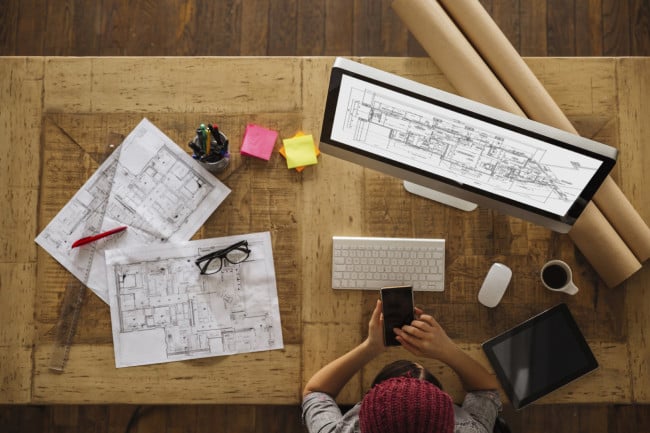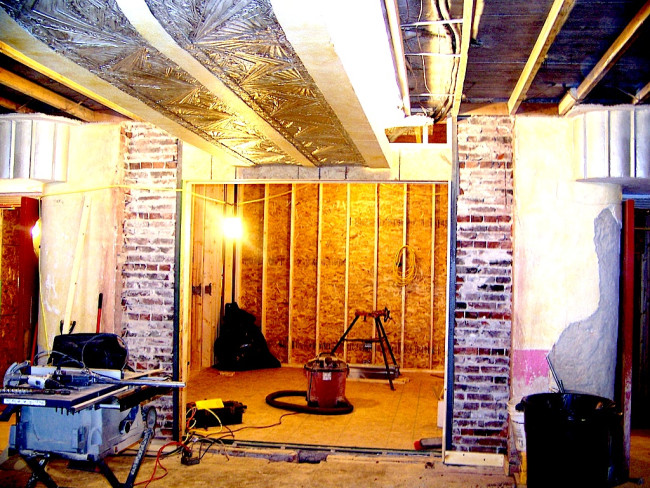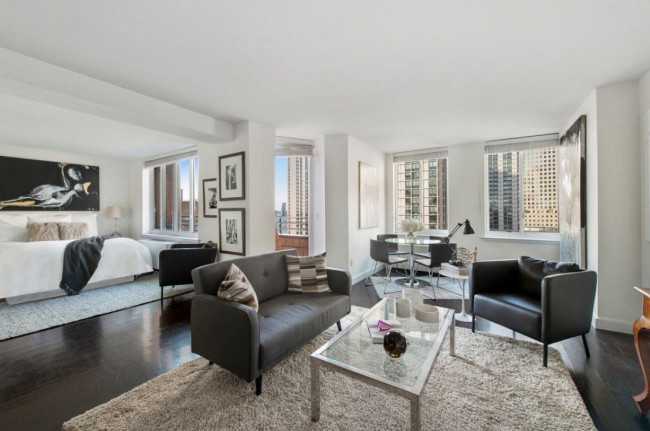A recipe to fix up a cookie-cutter Lower East Side apartment
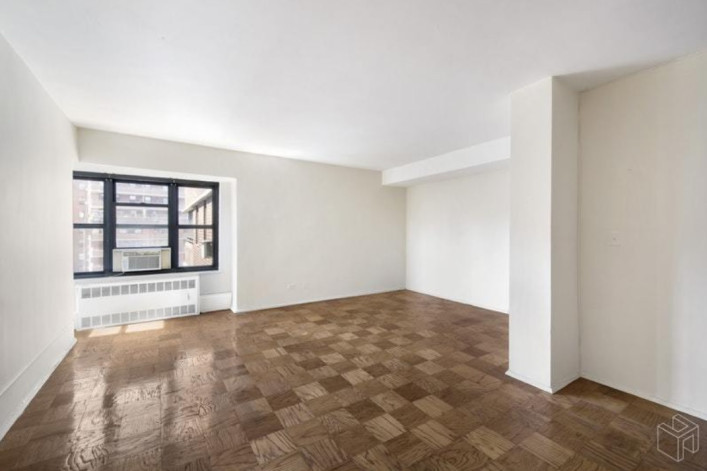
The light in the living room makes it look like "the walls have at least 15 different shades of white."
Water and city views are coveted by Manhattanites, but views of a brick building across the way? No one covets those. Yet that’s unfortunately all that this Lower East Side one bedroom, 264 East Broadway, #C1702, has to offer. While you won’t be able to do anything about what’s outside those windows, architect Richard Alan Goodstein of Brooklyn’s nC2 architecture has lots of ideas on how to overhaul the interior of this $749,000 co-op.
In this week’s Reno Ready, he describes exactly what he’d do to spruce the place up, including opening up the kitchen and widening the entryway.

Open up the living room
Closet: Goodstein dislikes the fact the living room (shown top) feels cramped the second you enter the apartment. He recommends cutting back the extra-deep coat closet just inside the front door in order make the entryway wider. “It’ll make the whole apartment feel more generous if the entry point is not a narrow hallway,” he says. The closet work for the entire apartment should cost around $5,000 or so.
Floors: “They look fine to me,” Goodstein says. He advises sanding them down and staining them with a clear coat of matte finish so they don’t look too shiny. This half-pint bucket is $11 on Amazon.com.
Paint: Goodstein says the walls have at least 15 different shades of white, depending on how light reflects off of them To combat this, he suggests “finding the absolute brightest white that exists and painting almost everything in that color,” including the ceiling. He prefers matte paint on all surfaces. “It just looks better,” he says. “The glossier a paint gets, the more it shows imperfections.” A gallon of Benjamin Moore’s Cloud White is $75.
He’d treat the wall with the window and radiator a bit differently, painting it very dark to match the window frame. “It’ll make the windows feel a little bit bigger that way, and make them feel like more of a component than just a hole in the wall,” he says. A gallon of Benjamin Moore’s Black is also $75.
Window treatments: Goodstein would choose white wood horizontal blinds “because they’re adjustable and you can direct the light.” He also notes that he “would absolutely not do a color or anything with a wood grain stamped on it because it just looks fake.” Custom horizontal wood blinds will probably cost in the $900 range.
Lighting: “That ceiling is a concrete slab and you can’t channel electrical lines into a slab,” Goodstein explains. While he isn’t generally a fan of track lighting, he says that he might consider putting a track along the left wall or under the beam on the right side and let it illuminate some artwork on the walls. He prefers track heads that aren’t very decorative. He’d also put up a few lamps. Prices for this single-circuit track start at $24 at Lightology. These track heads are $90 each, also at Lightology. Prices for this Tolomeo Mega Floor Lamp start at $945 on YLighting.com.
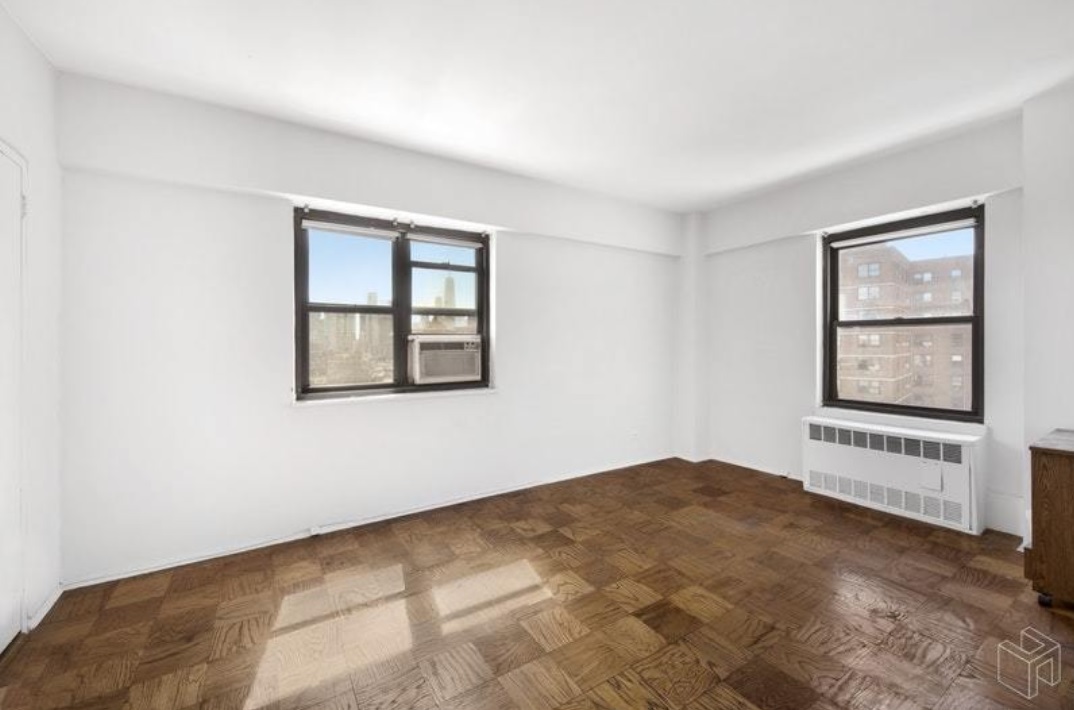
Keep it consistent in the bedroom
Floors and walls: To keep things somewhat uniform throughout the apartment, he’d put a clear coat of matte finish on the flooring, paint the walls and ceiling with Benjamin Moore’s Cloud White, and put up horizontal wooden blinds in here, too. “When they’re closed, they’re almost like blackout shades,” he explains.
Closet: Because he’s suggests making the entryway closet smaller, Goodstein would build a wall of closets along the left-hand side of the bedroom. He proposes moving the bedroom door a little bit north in order to accommodate this new two-foot deep closet. He’d also add louvered swing doors to make the closet more easily accessible. Doors range about $100 to $400.
Air-conditioner: The only logical place to put the bed is across from the window that currently has the AC in it. Since there is another window in the room, Goodstein proposes moving the air-conditioner there. “That way you can sit in bed and enjoy the view,” he says.
Lighting: “You don’t need overhead lights in a bedroom,” Goodstein says. He recommends either going with track lights on the wall behind the bed or floor lamps. This Perch Swingarm floor lamp by Sonneman Lighting is $440 at Lumens.
Radiator: Goodstein hates the unsightly radiator, so he’d recommend building a cover to hide it. A custom-built enclosure will cost between $750 and $1,500.
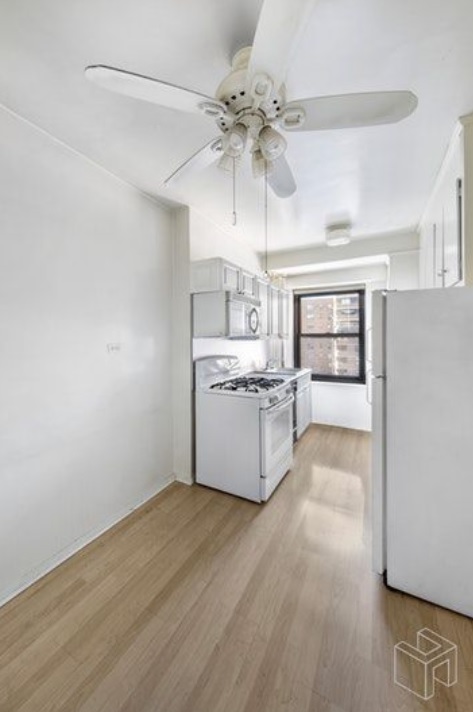
Knock down the kitchen walls
Walls: Goodstein would knock down all the walls in here except for the one behind the oven, which backs up against the bathroom. The kitchen will then be open to the living space. He’d have to move the fridge, of course, but he’s not sure where he’d move it to. “It might migrate to the far left wall,” he says. Or it might end up by the window. Prices for this demo work will vary based on contractor.
Countertops/Backsplash: “There’s no countertop space on either side of the sink and range, but you really want working space on both sides of those elements,” he says. He recommends adding countertop space on both sides. He’d consider quartz because it’s low-maintenance. “But it’s not cheap,” he says. It’d probably be $4,000 with installation for this room. He’d also run it up the walls to serve as a backsplash.
Cabinets: There are only a handful of cabinets in the kitchen, but Goodstein would lose them and swap in new cupboards, including under and on top of the new countertops. He’s not sure if he’d go with wood or white or a color. That would depend upon a client’s taste and financial situation. If the budget is limited, he’d recommend IKEA cabinets. “They look pretty good, and if they get beat up, you can easily replace the doors.” If there’s more wiggle room, he’d go the custom route. IKEA cabinets will be around $2,500 or so. Custom will be $10,000 or more.
“It’s really popular now to do the lower cabinets a different color than the upper cabinets,” he says, noting that if the occupant is interested in that look, he might go with dark blue on the lower level and wood on the upper level. “It might be nice to do something less visually heavy for the upper cabinets.”
Appliances: “I’d probably replace them,” he says, noting that his default is usually stainless steel, but that he might also opt for panels on the fridge and dishwasher in order to make the kitchen look more uniform. This Blomberg 22-inch panel-ready refrigerator is $1,599 at AJMadison.com. This Bosch panel-ready dishwasher is $939, also at AJMadison.com. This 30-inch Maytag gas range is $1,777, also at AJMadison.com.
Lighting: There are two points already built into the ceiling, so Goodstein would use those. “This ceiling fan looks like it’s off the shelf from Home Depot,” he says. He’d replace it with a new one—“not something highly decorative, something more low-key and functional,” he says. He’d add a pendant light to the other light point, which he thinks will be above a small dining table. Prices for this Ball Ceiling Fan from The Modern Fan Company start at $364 at YLighting.com. Prices for this Andros Pendant Light by A-19 start at $141, also on YLighting.com.
Floors: “If you’re taking down all the walls around the kitchen, you’ll want to match the flooring to the rest of the apartment,” Goodstein says. If you can’t find the exact flooring that’s in the living room and bedroom, he’d recommend replacing the flooring throughout the unit. If money’s no object, he’d go with oiled walnut, which can cost $30 per square foot. For folks looking to save some cash, he’d recommend standard strip character-grade flooring, which is flooring that has imperfections such as knots or color variations that give it character. “It’s not very uniform,” he says. “It’s the cheap stuff that gets sorted out, but if the flooring guy is good enough, and the imperfections are evenly distributed, it can be very striking.” This should cost significantly less, maybe $5 to $7 per square foot.
Sink: If the sink’s usable, Goodstein would keep it. If not, he’d get a new one. This Kraus under-mount sink is $270 at The Home Depot.
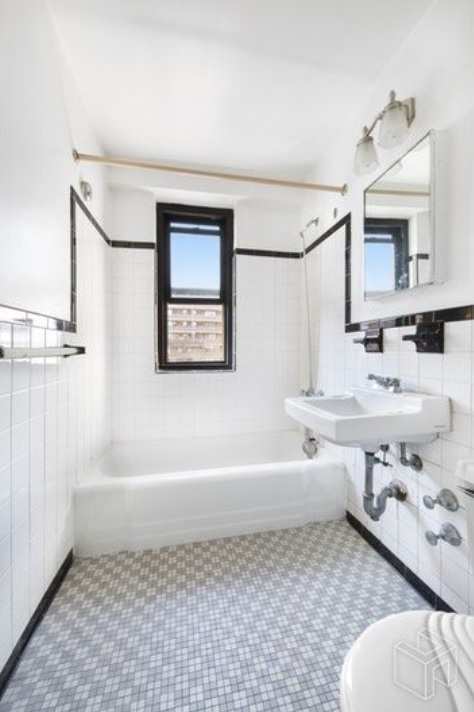
Bathroom can stay as is
“It’s kind of ok,” Goodstein says, noting that he thinks it might have been redone relatively recently to look like a typical 1940s New York City bathroom.
Floor: “They look like new tiles,” he says. “Part of me is always really reluctant to touch anything that’s serviceable.” He’d probably keep them.
Wall tiles: Same with the wall tiles. They look relatively new, so he’d hang onto them.
Shower curtain rod: Goodstein absolutely hates the gold rod, which seems out of place in this bathroom. He’d swap it out for a silver one that’ll match the other metals in here. This silver tension rod is $30 on Amazon.com.
Sink: Like the rest of this bathroom, the sink appears serviceable. But if he were to upgrade the space, he’d add a vanity cabinet with storage since there isn’t any in here at the moment. He’d recommend something with legs or feet rather than something that sits directly on the floor because “if it’s in the middle of the space, you want it to look like a piece of furniture,” he says. This Verona single-vanity is $775 at Wayfair.
Toilet seat: He can’t stand the weirdly textured toilet seat, so he’d trash it and get a new one. This quiet-close toilet seat is $27 on Amazon.com.
You Might Also Like

















